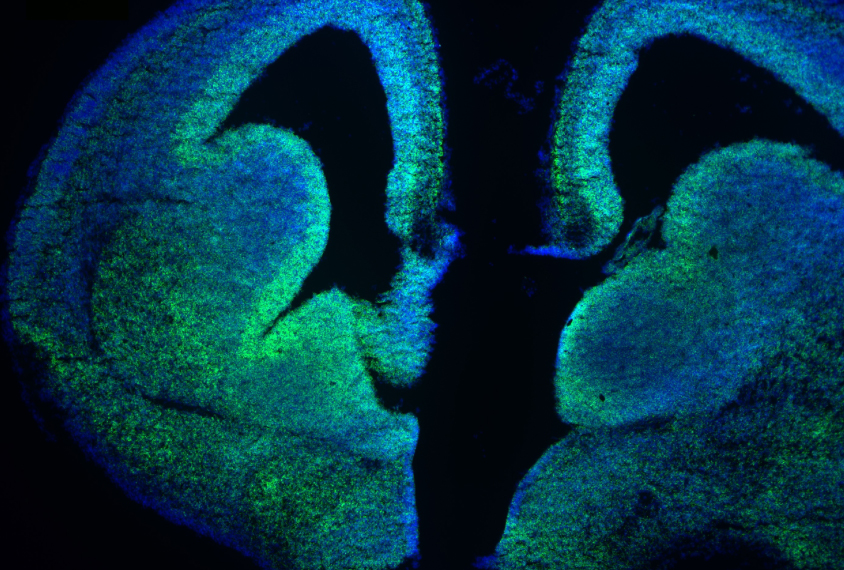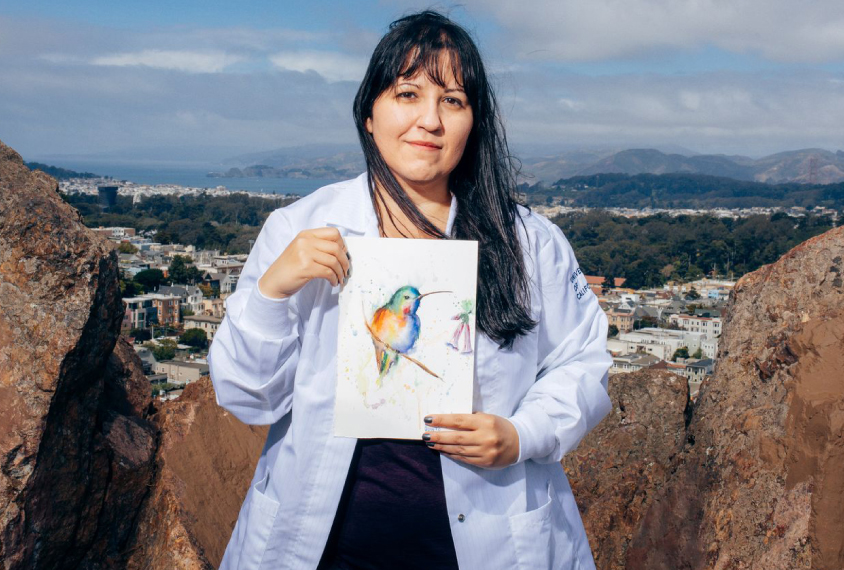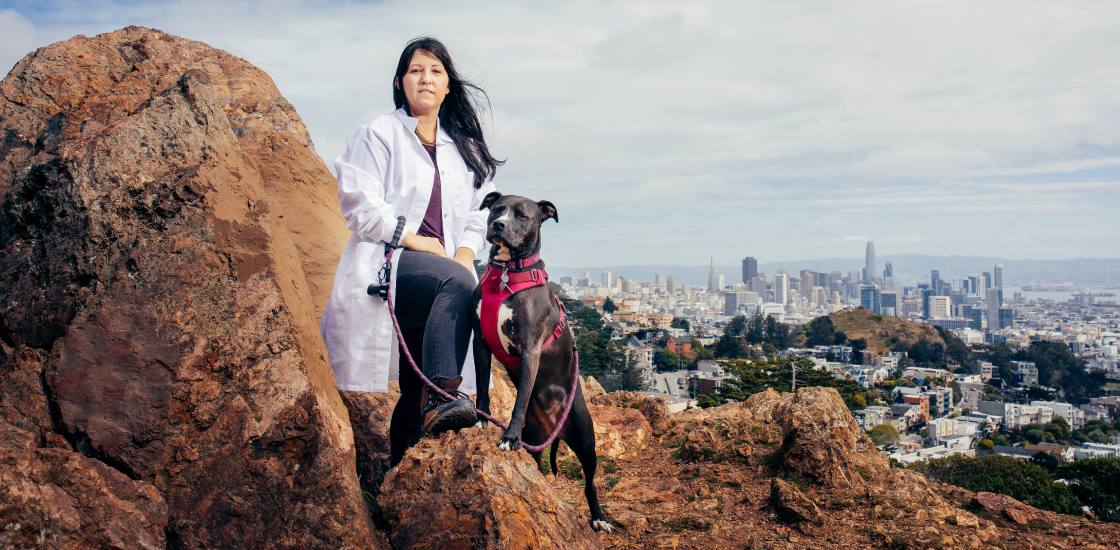Ask Georgia Panagiotakos where she is from, and she’ll tell you that she was born in the Brooklyn neighborhood of Bay Ridge in New York City. But she’ll also point out that her neurodevelopment began in a small Greek village where her mother lived shortly before her birth — a fitting observation from a researcher working to understand how cells decide what to become.
Panagiotakos is particularly focused on how cell differentiation unfolds in people with neurodevelopmental conditions, including autism. But her interests — from world history and Minnie Mouse to Nobel laureate Barbara McClintock and the mitochondria of hummingbirds — are as far-flung as her “concrete jungle” birthplace and “prolific olive-oil-producing” ancestral home.
Panagiotakos, a Sandler Fellow in biochemistry and biophysics at the University of California, San Francisco (UCSF), sees her varied interests as a way to hold on to the fun of science amid the drag of paper rewrites, grant deadlines and long hours, particularly during the isolation of the past year. Also helping with the isolation is her newly adopted pit bull mix, Ellie. Spectrum spoke to Panagiotakos via Zoom about her coffee habit and lab philosophy, and Ellie’s apparent lack of skepticism.
Spectrum: What is your Zoom background right now?
Georgia Panagiotakos: This is actually what got me into autism research. I’ve always been really interested in how immature cells make decisions about their fate. As a graduate student I transitioned into a lab that was focused on calcium signaling, and specifically on a monogenic, syndromic form of autism called Timothy syndrome, which is caused by a point mutation in one exon of a gene that codes for a specific calcium channel.
I captured this image while looking for that exon in the developing brain with a technique called in situ hybridization. It was the first indication we had that the exon mutated in this disorder is actually expressed in the immature progenitors of the developing brain, which was not really known before. It gave us some indication that maybe the decision of cells to become a specific cell type might be affected in this particular form of autism. It’s the first in situ experiment I ever did as a graduate student, and it’s still my favorite image.

S: What big question drives your research?
GP: I am intrigued by the question of how cells make choices and how they are able to integrate information from their environment with their internal genetic programs to make decisions about what kinds of neurons or glial cells they’re going to become.
Layered on top of that is how specific environmental signals, like electrical activity, influence that process. And then how genes that are mutated in developmental conditions such as autism can disrupt signaling pathways that are driven by electrical activity to change cell fate and the relative abundance of cell types in the brain. Everything that we do, either directly or indirectly, touches on these questions.
S: Is there a person you’d like to work with but haven’t yet?
GP: Right now, I’m especially excited about the work of Guillermina López-Bendito. She works on thalamocortical circuitry and how the activity of thalamic neurons can shape how the cortex develops.
Rosa Cossart and Natalia de Marco García are two developmental neuroscientists who are also really focused on how activity patterns in developing circuits contribute to the emergence of cortical networks. They’re doing some really beautiful work, and I would love to get in on that.
S: What does a typical day look like for you right now?
GP: I get up early in the morning and I take Ellie hiking every day. We’re lucky living in San Francisco, because we have a ton of little hiking trails to choose from.
I have to have a coffee first thing, and I’ll screen emails. And then either I will start a barrage of Zoom meetings or work on grants or papers, or read if I have time. I really am a total stickler about meeting with my lab members once a week, individually. It’s super important, especially during this very bizarre time.
More recently, we’ve started a joint lab meeting with another principal investigator at UCSF, Licia Selleri, who works on craniofacial development and has become a trusted mentor and close friend in recent years. These weekly meetings have turned into this great thing during the pandemic in particular, because they give us an opportunity to interact with different people and to learn about something totally different.
S: When and where are you most productive?
GP: I’m a very bursty person in terms of productivity. Once I hit a groove, I just cannot stop. I’ll start working and then completely forget myself, miss lunch, that sort of thing. But then there are other days where I find it challenging to focus unless it’s totally quiet or I’m in a different environment.
When we first locked down in San Francisco, we were still able to go out and spend time alone outside. I would often take just a picnic blanket and Ellie and my laptop, and I would go sit on the grass in a park and just work there, and it was phenomenal.
S: What are you reading right now?
GP: I have a tendency to have several books on my nightstand, all of which are partly finished. I’ve been on a real historical kick lately. Right now, I have “The Eighth Day of Creation” by Horace Freeland Judson, which is basically a history of molecular biology. I’m also reading “The World of Yesterday” by Stefan Zweig, which is a memoir set during the “golden age” of Austria.
I’ve been rereading “The Plague,” by [Albert] Camus. It’s been interesting to draw parallels between how that book progressed and what’s happened in our world in the past year. I want to know, what can we learn from history? So I also reread a book Gina Kolata wrote called “Flu: The Story of the Great Influenza Pandemic of 1918 and the Search for the Virus That Caused It.”
S: Do you subscribe to any journals or magazines in print?
GP: I get the table of contents of my favorite journals, and then I pretty much do all of my paper reading online, though I often print out favorite papers to read them more carefully and write notes all over them. We recently published in Genes & Development, and we got the cover, so they sent us a copy, but I actually don’t receive anything in print. Oh my, I wonder if that’s a reflection of my age.
When I was still a research assistant, my principal investigator used to say how excited she would be whenever she would get the print copy of a certain journal, and she would thumb through it from beginning to end. But not so much for me.
S: What do you like to eat or drink while you’re working?
GP: Well, I’m gonna just hold up my mug here. This is a latte. I am an avid coffee drinker, especially Greek coffee. This mug is from a coffee shop called Java Girl that was a block and a half away from Sloan Kettering, where I used to work as a research assistant. We used to go there for coffee breaks. I keep a part of New York with me all the time.
If I’m going to snack, it’s usually going to be a banana or some kind of fruit. But coffee is a must.
S: Does your lab have a mascot?
GP: We have two! The first one is this watercolor painting that a friend of mine brought back to me after he hiked the Inca Trail with his father, right around the time I started my lab. It was a hummingbird. I’m absolutely obsessed with these animals. I think they’re extraordinary. Their mitochondria are super cool. The fact that they’re able to levitate while they eat — that would be an awesome skill.
His appearance looked a bit skeptical. And we joke that that’s how we should always look at our data. We should always question what we’re seeing and make sure that we’re rigorous. So we called him the Skeptical Hummingbird, and he was the original mascot of the lab.

And then, of course, when Ellie was adopted, she very promptly tried to overthrow him. She’s the opposite side of him. She accepts all. She’s very enthusiastic. She reminds us to take every win with joy.
When the pandemic first started, I would send a daily Ellie photograph out to the members of my lab. The pandemic was really wearing on everyone, especially when the lab was shut down. It was a lot of strain. The photographs seem kind of silly in hindsight, but it made people smile a little bit and initiated conversations about how everybody was doing. And she’s an extraordinarily photogenic dog. Her face broke a little bit of the anxiety that everyone accumulated during this time.
S: You have perhaps an unusually fun website for a scientist. Do you have a lab philosophy it communicates?
GP: My philosophy, as cheesy as it sounds, is that we are all a team, and that we are all accountable to one another. I always tell my lab what I’m working on at any given moment. I will share things that I write, and I want them to be totally engaged with what our goal is. Similarly, I expect that of them — that they will be accountable to one another and help each other out.
I’m really proud to say that it’s a culture we built together as a group from the beginning, and that has persisted. And it’s been most evident this past year. To see people doing things for one another to help their projects move forward, that for me is the most important aspect of our culture. And to not forget that we are really lucky to be able to do this. Science is fun, at its core. Despite all of the stuff that exists that makes it maybe a little less fun, like grant rejections or papers that take a really long time to get published, it’s really exciting to have the opportunity to do science every day. And I think our website reflects that.






